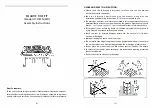
Ventilation requirements / provide adequate air for combustion.
The fresh air requirements of this appliance must be met within the
space where it will be installed. Ventilation is essential when using
a Solid-Fuel-Burning heater. In well insulated and weather tight
homes, it may be difficult to establish a good draft up the chimney
(caused by a shortage of air in the home). The lack of air is caused
by many common household appliances which exhaust air from the
home (such as a furnace, heat pump, air conditioner, clothes dryer,
exhaust fans, fireplaces, and other fuel burning appliances). Also,
the combustion process of this heater uses oxygen from inside the
dwelling. If the available fresh air delivery in the dwelling is insufficient
to support the demands of these appliances, problems can result
(i.e. excessive negative pressure can develop in the dwelling which
will affect the rate at which this appliance can draft thus resulting in
performance problems. To correct this problem it may help to open
a window (preferably on the windward side of the house) or install
an optional outside air kit.
SMOKE DETECTORS - Since there are always several potential
sources of fire in any home, we recommend installing smoke detec
-
tors. If possible, install the smoke detector in a hallway adjacent to
the room (to reduce the possibility of occasional false activation
from the heat produced by the stove). If your local code requires a
smoke detector be installed within the same room, you must follow
the requirements of your local code. Check with your local building
department for requirements in your area.
The following is for “fireplace inserts” only
These heaters are designed to be installed into an existing masonry
fireplace (built to UBC 37 or ULC S628 standards) or factory-built,
solid-fuel and wood-burning fireplaces (listed to UL 127 or ULC
S610) only.
Installations in Canada require a full-length liner, type HT (2100°
Fahrenheit) listed to UL 1777 (United States) or ULC S635 (Canada)
standards.
Canada Installations into Masonry Fireplaces - The chimney liner must
conform to the Class 3 requirements of CAN / ULC – S635, Standard
for Lining Systems for Existing Masonry or Factory-Built Chimneys
and Vents, or CAN / ULC – S640 Standard for Lining Systems for
New Masonry Chimneys.
The fireplace in which this wood-burning insert is to be installed
must be thoroughly cleaned if it has been used to burn wood or
synthetic logs. Have the chimney and all inside surfaces of the
fireplace brushed and vacuumed so that no soot, embers, or loose
combustion deposits can be drawn into the heat circulation blower
and blown into the living area.
If any portion of the chimney system shows signs of structural or
mechanical weaknesses, such as cracks, leaky joints, corroded or
warped surfaces, the faulty portion must be repaired or replaced
prior to installing this appliance.
3
Besoin en ventilation : fournir un apport suffisant d’air pour la
combustion. L’apport d’air frais pour cet appareil doit être comblé
et ce à même l’espace où l’appareil sera installé. L’aération est
essentielle lors de l’utilisation d’un pôele à combustion solide.
Dans des maisons bien isolées et hermétiques, il peut être difficile
d’obtenir une bonne tire dans la cheminée (causé par un manque
d’air à l’intérieur de la maison). Un manque d’air peut être causé par
plusieurs appareils ménagers qui évacuent l’air de la maison (tels
que les fournaise, thermopompe, climatiseur, sécheuse, ventilateur,
foyer et autres appareils à combustion) Aussi, le processus de
combustion de ce poêle utilise l’oxygène provenant de l’intérieur
de la maison. Certains problèmes peuvent résulter d’un apport
d’air insuffisant pour alimenter la demande de ces appareils (c.i.e.
pression négative excessive qui se développe dans la maison et qui
peut affecter la vitesse à laquelle l’appareil peut tirer l’air résultant
dans une baisse de la performance). Pour corriger cette situation,
ouvrez une fenêtre (préférablement du côté face au vent) ou installez
un ensemble optionnel de prise d’air extérieur.
DÉTECTEURS DE FUMÉE - Comme il existe plusieurs sources poten-
tielles d’incendie dans une maison, nous recommandons l’installation
d’un détecteur de fumée. Si possible, installez le détecteur de fumée
dans un couloir adjacent à la pièce (pour réduire les possibilités oc
-
casionnelles de fausses alarmes causées par la chaleur produite par
le poêle). Si un règlement dans votre région vous oblige d’installer
un détecteur de fumée dans la pièce, vous devez respecter cette
réglementation. Communiquer avec les autorités locales en bâtiment
ou le service de prévention des incendies de votre région.
Ce qui suit concerne les poêles encastrables seule-
ment
:
Ces appareils sont conçus pour être installés dans un foyer de maçon
-
nerie existant (construit selon UBC 37 ou selon la norme ULC S628)
ou dans un foyer à combustion solide au bois préfabriqué (certifié
selon UL 127 ou ULC S610) seulement.
Les installations au Canada requièrent un chemisage à l’aide d’un
tubage pleine longueur de type HT (2100° Fahrenheit) certifiée selon
UL 1777 (USA) ou selon la norme ULC S635 (Canada)
Installation au Canada dans un foyer de maçonnerie – Le tubage doit
répondre aux exigences de la Classe 3 CAN / ULC - S635, "Standard
for Lining Systems for Existing Masonry or Factory-Built Chimneys
and Vents", ou CAN / ULC – S640 "Standard for Lining Systems for
New Masonry Chimneys".
Le foyer dans lequel l’encastrable sera installé doit être intégralement
nettoyé s’il a été utilisé pour chauffer au bois ou avec des bûches
synthétiques. Assurez-vous que la cheminée et les parois intérieures
du foyer sont brossées et aspirées afin qu’aucune suie, cendres ou
dépôts de combustibles ne puissent être aspirés et rejetés dans
l’espace habitable.
Si une partie de la cheminée démontre des faiblesses mécaniques ou
de structure tels que des fissures, joints perméables, surfaces rouil
-
lées ou gauchies, la portion abîmée doit être réparée ou remplacée
avant d’installer l’appareil.


























